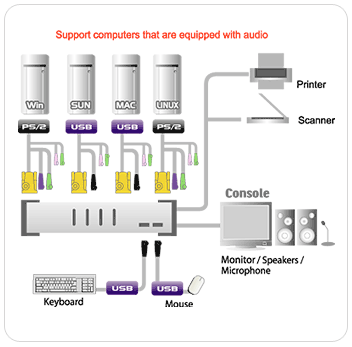
What is KVM
KVM is an acronym for keyboard, video (monitor) and mouse, and is otherwise called a PC switch or electronic switch. However, this different from the conventional data switch. The main function of KVM is to control, switch and manage many PCs via a single keyboard, monitor and mouse. According to the basic PC function design, as the PC is starting up, the operating system will automatically detect the signals of the keyboard and mouse. After confirmation of connectivity, the screen then enters the start up page. As a result, a single PC (CPU/Server) naturally complements the start up operations of the keyboard and mouse. If you need to control multiple PCs, then you need to purchase several sets of keyboard, mouse and monitor. However, this is not the most effective way of management as not only is it space-consuming, but also costly, and keeping a row of large CRT monitors may be problematic. Thus, the KVM was “born” under the demands of saving space, costs and increasing management efficiency. When purchasing a KVM, the choice is often made based on the number of PCs that you need to control. Low port number KVMs are convenient to use, without the installation of extra software, and can be easily managed using hot keys or switch keys. Some of these low port number KVMs do not need an exteral power supply. Due to environmental needs, multiple ports, high-level KVM switches are designed to 1U or 2U in size and can be installed on the server rack. These KVM switches can use the Internet to manage power supply and control the start up or shut down of PCs.

The main function of a KVM is to use one of keyboard, monitor and mouse to start multiple PCs, so it is important to simulate the keyboard and mouse signals to each PC and not influence the CPU operations during switching. Other important factors to consider when buying a KVM is the stability of the monitor resolution, whether or not it supports multiple platforms, and the compatibility of operating systems with different branded keyboards and mice. Every KVM Switch has a maximum number of PC connections. A single KVM switch can provide as few as two CPU ports, while a multiple KVM switch installation can offer more than 4000 CPU ports. As the number of connected PCs increase, the technology needs are higher (for example, signal identification) and the different ways of management increase (for example, remote control, multiple segmentation, high-level security, etc.) in order to meet the management demands of different environments. Currently, the remote control solutions use both hardware (KVM) and software (for example, PC Anywhere, VNC, OpenSSH, Microsoft Telnet Service, etc.). To understand the comparison between hardware and software, please refer to the Remote Control Solution column.
Previously, KVM has been used in server rooms and data information centers. An average-sized room will contain 16 to 32 servers, whereas a large room may contain over 100 servers. As the trend is for PC prices to become increasingly lower, many people are able to purchase a second PC or laptop, making KVM necessary for the average consumer. Advancements in technology, new specifications, innovative concepts and new applications have pushed KVM to evolve (for example, KVM + Peripheral / KVMP¡BKVM + Fast Ethernet / KVME, Wireless KVM, KVM on the Net, etc.). These new KVM are increasingly popular in the consumer market and as digital appliances become more mainstream, KVM’s multi-faceted development can cater to this market and create new concepts that may not have been previously possible. Some basic terminology for KVM Switch specifications include: 1. Ports The number of ports is indicative of the number of PCs that can connect to the KVM. For example, for an 8 Port KVM Switch, a single keyboard, monitor and mouse can control up to 8 PCs. Currently, the most common number of ports for KVM is 2 Port, 4 Port, 8 Port, 16 Port and 32 Port. When the number of PCs surpasses thirty-two, cascading or daisy chaining the KVMs is then used to connect to the PCs. In order to more conveniently control and run many PCs, some KVM have various functions to assist in management. For example, using functions such as hot keys, OSD, broadcasting, etc. Some innovative KVM companies also develop proprietary embedded core logic chip in order to increase operational stability and the efficiency of the signal execution. Note: Please refer to the high-end KVM feature article to find out more about connectivity. 2. Console This term refers to the control that is used to manage the keyboard, monitor and mouse of the PC. Normally, a console has three different ports for the keyboard, mouse and monitor. The specifications for the keyboard and mouse connector are USB and PS/2, whereas the specifications for the monitor are DVI and HDB 15. Note: Console KVM that support audio have ports for the microphone and speakers. KVM that are specifically used for SUN and MAC have different ports. 3. CPU This term indicates the connected PC. A single CPU port on a KVM has three different signal ports (keyboard, mouse and monitor) to connect with the ports on the PC. In order to save on the BOM and to increase the convenience of installation, some companies manufacture their own proprietary cables, combining the afore mentioned three cables into one. This not only can shorten the length of the KVM appearance, but also simplify the desktop space. Although proprietary cables have many advantages, however it is also easily influenced by other signals. It is recommended that a professional KVM brand be chosen to minimize these problems. Note: The KVM that supports audio has ports for the microphone and speakers on the CPU port. KVM’s categories can be divided as follows: small office and home office (SOHO); small and medium-sized business (SMB); and large, high-end global enterprise-level KVM. Many KVM companies then further divide high-end KVM to remote-controlled high-end KVM and nearby-controlled high-end KVM. For a further explanations of the different types of KVMs, please visit the home page.
相关资讯
- 暂无相关内容





